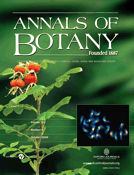Ver ítem
- xmlui.general.dspace_homeCentros e Institutos de InvestigaciónCIAP. Centro de Investigaciones AgropecuariasInstituto de Fisiología y Recursos Genéticos VegetalesArtículos científicosxmlui.ArtifactBrowser.ItemViewer.trail
- Inicio
- Centros e Institutos de Investigación
- CIAP. Centro de Investigaciones Agropecuarias
- Instituto de Fisiología y Recursos Genéticos Vegetales
- Artículos científicos
- Ver ítem
Reductions in Maize Root-tip Elongation by Salt and Osmotic Stress do not Correlate with Apoplastic O2•− Levels
Resumen
Background and Aims: Experimental evidence in the literature suggests that O2•− produced in the elongation zone of roots and leaves by plasma membrane NADPH oxidase activity is required for growth. This study explores whether growth changes along the root tip induced by hyperosmotic treatments in Zea mays are associated with the distribution of apoplastic O2•−.
Methods: Stress treatments were imposed using 150 mM NaCl or 300 mM sorbitol. Root elongation
[ver mas...]
Background and Aims: Experimental evidence in the literature suggests that O2•− produced in the elongation zone of roots and leaves by plasma membrane NADPH oxidase activity is required for growth. This study explores whether growth changes along the root tip induced by hyperosmotic treatments in Zea mays are associated with the distribution of apoplastic O2•−.
Methods: Stress treatments were imposed using 150 mM NaCl or 300 mM sorbitol. Root elongation rates and the spatial distribution of growth rates in the root tip were measured. Apoplastic O2•− was determined using nitro blue tetrazolium, and H2O2 was determined using 2′, 7′-dichlorofluorescin.
Key Results: In non-stressed plants, the distribution of accelerating growth and highest O2•− levels coincided along the root tip. Salt and osmotic stress of the same intensity had similar inhibitory effects on root elongation, but O2•− levels increased in sorbitol-treated roots and decreased in NaCl-treated roots.
Conclusions: The lack of association between apoplastic O2•− levels and root growth inhibition under hyper-osmotic stress leads us to hypothesize that under those conditions the role of apoplastic O2•− may be to participate in signalling processes, that convey information on the nature of the substrate that the growing root is exploring.
[Cerrar]

Autor
Bustos, Dolores Angela;
Lascano, Hernan Ramiro;
Villasuso, Ana Laura;
Machado, Estela;
Senn, Eugenia;
Cordoba, Alicia Beatriz;
Taleisnik, Edith;
Fuente
Annals of Botany 102 (4) : 551–559 (October 2008)
Fecha
2008-10
Editorial
Oxford Academic Press
ISSN
0305-7364
1095-8290
1095-8290
Formato
pdf
Tipo de documento
artículo
Palabras Claves
Derechos de acceso
Abierto
 Excepto donde se diga explicitamente, este item se publica bajo la siguiente descripción: Creative Commons Attribution-NonCommercial-ShareAlike 2.5 Unported (CC BY-NC-SA 2.5)
Excepto donde se diga explicitamente, este item se publica bajo la siguiente descripción: Creative Commons Attribution-NonCommercial-ShareAlike 2.5 Unported (CC BY-NC-SA 2.5)


